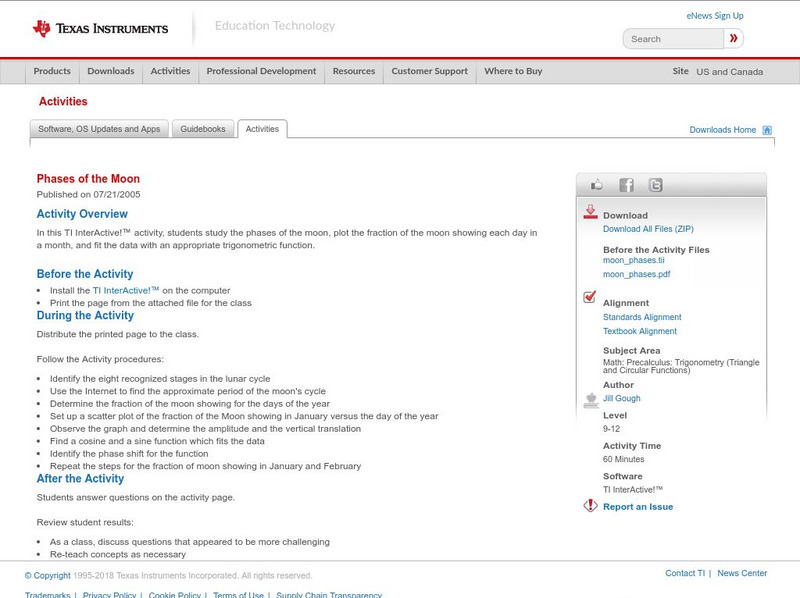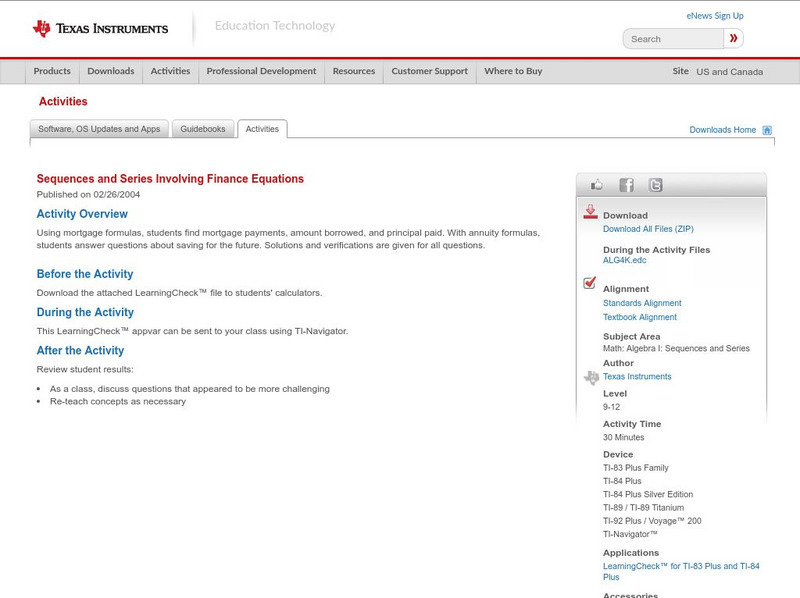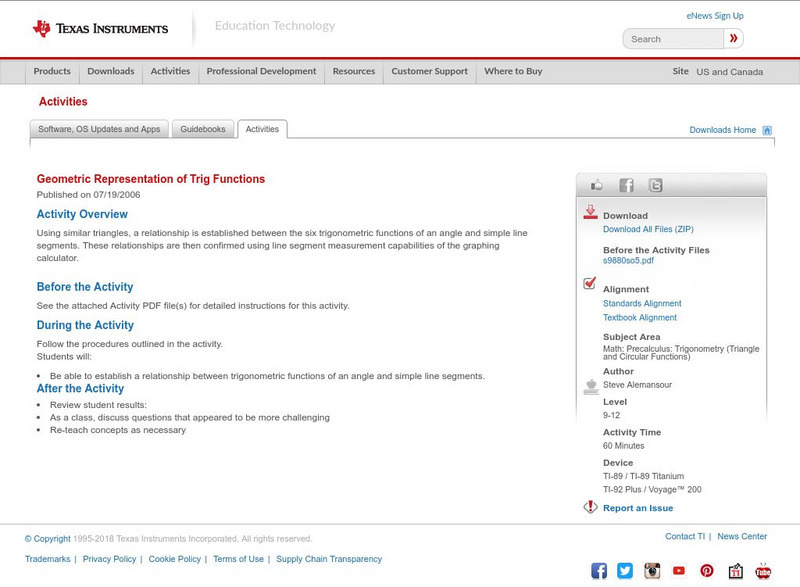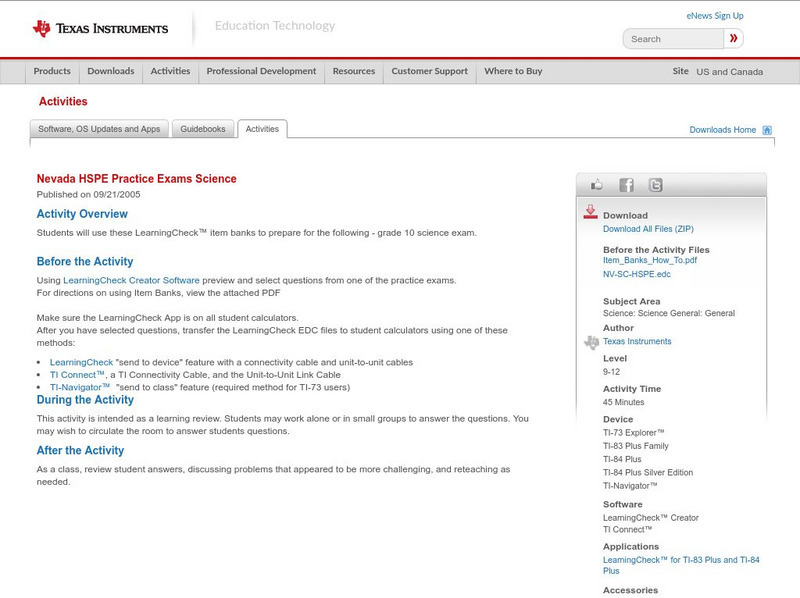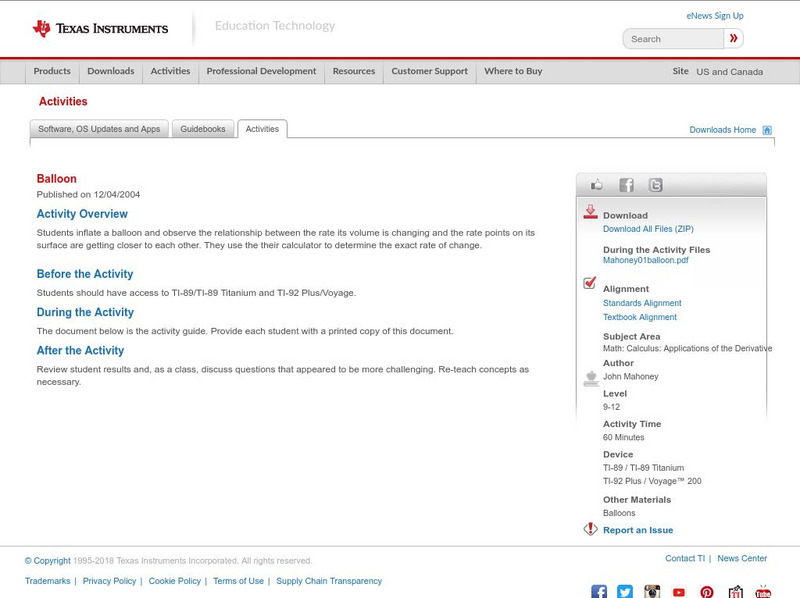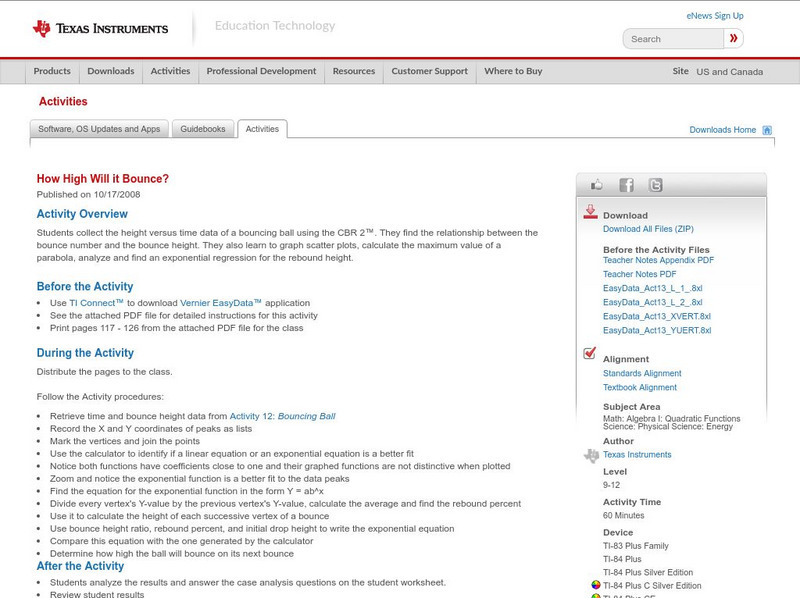Texas Instruments
Texas Instruments: Phases of the Moon
In this TI InterActive! activity, students study the phases of the moon, plot the fraction of the moon showing each day in a month, and fit the data with an appropriate trigonometric function.
Texas Instruments
Texas Instruments: Form a Line Using Ti Navigator
In this lesson concept we use the Activity Center to build some basics in students understanding of linear functions. The linear relationship is clearly one of the big ideas of the algebra curriculum, and it paves the way for a deeper...
Texas Instruments
Texas Instruments: Piecewise Functions on Ti Interactive
Despite what most of us veiw as an excellent TI InterActive! Help file, my students have a difficult time getting the appropriate graphs after reading it. This is visual directions on how to enter piecewise functions in TI InterActive!...
Texas Instruments
Texas Instruments: Numb3 Rs: Have Your Cake and Eat It Too
Based off of the hit television show NUMB3RS, this lesson has students think about fair way to divide a quantity into even parts. Different algorithms are presented, including "I cut, you choose," and students are to choose which...
Texas Instruments
Texas Instruments: Getting Started With the Ti Navigator: What's My Line
This lesson introduces students to Activity Center and is intended to help students understand the meaning of slope and y-intercept. They will explore the relationships between symbolic expressions and graphs of lines by using Activity...
Texas Instruments
Texas Instruments: Sequences and Series Involving Finance Equations
Using mortgage formulas, students find mortgage payments, amount borrowed, and principal paid. With annuity formulas, students answer questions about saving for the future. Solutions and verifications are given for all questions.
Texas Instruments
Texas Instruments: Z Tests
Students will be lead through the process of using the calculator to solve z test problems.
Texas Instruments
Texas Instruments: Inverse of Two Temps
In this activity, students find a conversion equation that will calculate the corresponding Celsius temperature for any given Fahrenheit temperature. Students learn to graph scatter plots, analyze and graph linear equations, compute and...
Texas Instruments
Texas Instruments: The Tortoise and the Hare
In this activity, students develop patterns using two or more rational number quantities. They comprehend the concept of functions by understanding the relationship between these quantities and their sums.
Texas Instruments
Texas Instruments: Special Midpoint Quadrilaterals
Midpoint Quadrilaterals are quadrilaterals that are formed when consecutive midpoints of a quadrilateral are connected. This activity will use Cabri Jr. to investigate what properties an exterior quadrilateral has if its midpoint...
Texas Instruments
Texas Instruments: Geometric Representation of Trig Functions
Using similar triangles, a relationship is established between the six trigonometric functions of an angle and simple line segments. These relationships are then confirmed using line segment measurement capabilities of the graphing...
Texas Instruments
Texas Instruments: Dimensions and Area
In this activity, students discover the relationship between a change in the dimensions of a rectangle and the change in the corresponding area.
Texas Instruments
Texas Instruments: Traveling Shapes Motion Geometry
In this activity, students describe how to move a shape from one place to another in a plane. They learn about translations, rotations, and line reflections. [Requires Adobe Reader.]
Texas Instruments
Texas Instruments: Step by Step Activity Data Collection & Analysis
In this activity, students create a situation that produces linear behavior by stepping heel to toe and taking distance readings as each step is taken. Students then apply the properties of a linear function to develop a model for motion.
Texas Instruments
Texas Instruments: Connecting Factors and Zeros
Students will determine if a quadratic formula is factorable, then they will factor the equation, set each factor equal to 0, and solve for x.
Texas Instruments
Texas Instruments: Nevada Hspe Practice Exams Science
Students can use these LearningCheck item banks to prepare for the following - grade 10 science exam.
Texas Instruments
Texas Instruments: What Is Boiling?
In this lesson, students investigate the effects of heat on matter by studying boiling water.
Texas Instruments
Texas Instruments: Minimum and Maximum Perimeter
The students can use varying numbers of tiles to form shapes, and then find the minimum and maximum perimeter for each.
Texas Instruments
Texas Instruments: Balloon
Students inflate a balloon and observe the relationship between the rate its volume is changing and the rate points on its surface are getting closer to each other. They use the their calculator to determine the exact rate of change.
Texas Instruments
Texas Instruments: Alaska Tn and Hsgqe Practice Exams Math
Students can use these LearningCheck item banks to prepare for the following - 9th grade Alaska TN and HSGQE math and 10th grade Alaska TN and HSGQE math.
Texas Instruments
Texas Instruments: A Move in the Right Direction
Students physically provide motion data that is collected by a CBL and then graph the data. They determine if they "moved in the right directions" by comparing their graph with those printed in the activity.
Texas Instruments
Texas Instruments: Numb3 Rs: Maintaining Balance
Based off of the hit television show NUMB3RS, this lesson has students determine center of mass for a series of objects (approximate JENGA blocks), and then to push each level so that it "hangs over" the level below it. Following this,...
Texas Instruments
Texas Instruments: Video Tutorial Learn to Enter an Equation and Graph
This tutorial shows you how to graph an equation and find a particular Y value when given an X value.
Texas Instruments
Texas Instruments: How High Will It Bounce?
In this activity, students collect the height versus time data of a bouncing ball using the CBR 2. They find the relationship between the bounce number and the bounce height. They learn to graph scatter plots, calculate the maximum value...


